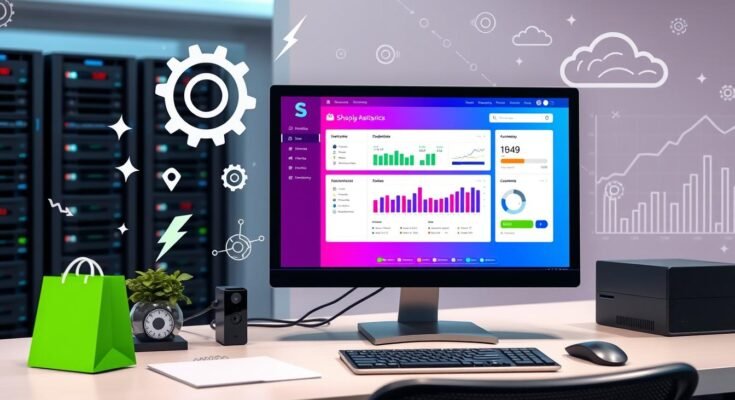Optimizing Your Shopify Hosting : Your Shopify store is key to your business’s success in the fast-paced e-commerce world. The performance of your online store greatly affects customer experience. Improving your Shopify hosting and store can make your site load faster, look better, and be more responsive.
This can lead to happier customers and more sales. It’s all about making your store run smoothly.
Key Takeaways
- Shopify’s recommended Dawn theme can help speed up your store’s load times.
- Minimalist themes generally result in faster load times, as they have less code and fewer features.
- The number of apps installed on your Shopify store can significantly impact its performance.
- Unoptimized images can slow down your Shopify store, so it’s important to compress and optimize them.
- Lazy loading can help accelerate the loading speed of your Shopify store by only loading content when it’s needed.
Understanding Web Performance Optimization
For Shopify merchants, making your website fast is key to a smooth shopping experience. This means focusing on three main areas: how quickly your site loads, how stable it looks, and how well it responds to users. By improving these, you can make your Shopify store better and meet your customers’ growing expectations.
Loading Speed
How fast your site loads is very important. It’s measured by Largest Contentful Paint (LCP). LCP shows how quickly the biggest part of your page appears. Making your site load faster can keep your customers happy and more likely to shop with you.
Layout Stability
Layout stability is also crucial. It’s measured by Cumulative Layout Shift (CLS). CLS checks if your page’s layout stays the same while it loads. A stable layout makes for a better user experience and avoids annoying mistakes, like clicking the wrong thing.
Responsiveness to User Interaction
How well your site responds to users is another key area. This is checked through First Input Delay (FID) and Interaction to Next Paint (INP). These metrics show how fast your site reacts to actions, like clicking or typing. Making your site more responsive can make shopping more enjoyable for your customers.
By focusing on these areas, Shopify merchants can make their sites better. This leads to happier customers, more sales, and a site that meets today’s standards.
“Improving site speed by just half a second could increase conversions.”
| Metric | Description | Ideal Target |
|---|---|---|
| Largest Contentful Paint (LCP) | Measures the time it takes for the largest content element on a page to load | Less than 2.5 seconds |
| Cumulative Layout Shift (CLS) | Tracks the visual stability of a web page, ensuring elements don’t unexpectedly shift or move | Less than 0.1 |
| First Input Delay (FID) | Evaluates how quickly a page responds to user interactions, such as clicking a button | Less than 100 milliseconds |
| Interaction to Next Paint (INP) | Assesses the responsiveness of a page to user interactions, including the time it takes for the page to update | Less than 200 milliseconds |
Factors Impacting Shopify Store Performance

In the world of ecommerce, website speed is key to success. The choice of theme and apps installed are big factors. They can make or break your Shopify store’s performance.
Optimized Shopify Themes
Using a modern, optimized Shopify theme is crucial. Themes from the Online Store 2.0 collection are made for speed. They have smaller files and efficient code, making your site faster.
Even a 0.1 second speed boost can increase conversions by 8.4%. It also leads to a 10% spending increase in fast-loading sessions.
Installed Apps and Third-Party Code
The apps and scripts on your store also impact speed. Sites that load in one second see a 2.5 times higher conversion rate. It’s important to check if apps and scripts are worth the performance cost.
Removing unused tags can also speed up your Shopify store. This helps in providing a better customer experience. It can lead to more sales and higher conversion rates.
Optimizing Your Shopify Hosting

As an ecommerce business owner, you know how crucial website speed is. Shopify offers fast servers and a CDN for quick loading times worldwide. But, to get the best shopify hosting performance, you need more than that.
Start by using a modern, optimized Shopify theme. Old or poorly made themes slow down your store. Keep your theme updated to ensure it’s fast and efficient.
Also, check your Shopify apps and third-party code. These integrations are great, but they can slow things down if not managed well. Go through your Shopify store integrations and remove any unused apps to keep your site running smoothly.
Don’t forget to optimize your tag manager. Too many unused or low-value tags can slow your store down. Streamlining your tags is key for better Shopify server optimization.
By following these tips, you can make the most of your Shopify hosting. Your online store will be fast and easy to use for your customers.
| Optimization Technique | Impact on Shopify Hosting Performance |
|---|---|
| Optimized Shopify Theme | Lightweight and efficient themes can significantly improve loading times. |
| Evaluating Installed Apps and Third-Party Code | Removing unused or low-value integrations helps maintain a lean and fast-loading store. |
| Optimizing Tag Manager | Streamlining tracking and analytics tags can reduce overhead and enhance performance. |
Practical Steps for Shopify Speed Optimization

Speeding up your Shopify store is key for a smooth user experience. It keeps customers happy and coming back. Here are some easy ways to make your store faster and more visible online.
Image Compression
Images are big and can slow down your site. Shrinking them from 20 MB to 300 KB can make your site 70% faster. Use tools like TinyJPG or TinyPNG to compress images without losing quality. Also, try Lazzy Load to delay image loading until they’re needed.
Minimizing Third-Party Scripts and Apps
Scripts and apps add cool features but can slow your site. Check your apps and scripts. Remove or optimize any you don’t need. Fewer scripts mean a faster site.
Choosing a Lightweight Theme
Your theme’s weight also matters. Pick a light, fast theme. Use system fonts to avoid font downloads and speed up your site.
Follow these steps to make your Shopify store fast and user-friendly. A quick site is good for both your customers and your SEO. Remember, speed is a big SEO factor.
Also Read: Increasing Revenue With Reseller Hosting Services
| Optimization Technique | Impact on Site Speed |
|---|---|
| Image Compression | Up to 70% improvement |
| Minimizing Third-Party Scripts and Apps | Significant improvement in responsiveness |
| Choosing a Lightweight Theme | Faster initial load times |
Conclusion
Optimizing your Shopify hosting and store is key for a smooth customer experience and more sales. Knowing how to improve web performance is crucial. This includes steps like compressing images and choosing a lightweight theme.
A fast website is vital today. A slow Shopify store can cause people to leave quickly. In fact, a one-second speed boost can lead to a 2% increase in sales page speed optimize your shopify store product page shopify website speed.
By improving your Shopify’s speed, you’ll make your customers happier and your business more successful. Shopify has tools to help you keep your site fast. Use these to make sure your store runs smoothly.
FAQs
Q: What are some easy steps to speed up my Shopify website?
A: To speed up your Shopify website, consider optimizing images, using a content delivery network, minimizing app usage, and regularly checking your store speed with a speed test. These easy steps can significantly improve your website performance.
Q: How does page load speed affect my Shopify store’s SEO?
A: Page load speed is a crucial factor for SEO as search engines prioritize faster websites. A faster Shopify store speed can lead to better rankings in search engine results, ultimately driving more traffic to your ecommerce store.
Q: What is the role of image optimization in improving Shopify performance?
A: Image optimization reduces the file size of images without sacrificing quality, which improves the page load speed of your Shopify website. This can enhance the overall user experience and positively impact your Shopify site speed.
Q: How can I test the speed of my Shopify store?
A: You can test the speed of your Shopify store using various online speed test tools. These tools provide insights into your store’s performance, including page load speed and areas for improvement.
Q: What are core web vitals and why are they important for my Shopify site?
A: Core web vitals are metrics that measure the user experience of a website, including loading performance, interactivity, and visual stability. They are important for your Shopify site because they directly influence both user satisfaction and search engine rankings.
Q: Can using too many Shopify apps slow down my website?
A: Yes, using too many Shopify apps can slow down your website by adding extra scripts and code that need to load. It’s best to evaluate the necessity of each app and remove any that are not essential to optimize your Shopify performance.
Q: How can I improve my Shopify store’s speed score?
A: To improve your Shopify store’s speed score, focus on optimizing images, reducing redirects, leveraging browser caching, and minimizing the use of heavy scripts. Regularly monitoring your site speed and making adjustments can also help.
Q: What impact does the speed of my Shopify store have on user experience?
A: The speed of your Shopify store directly impacts user experience; faster page load times lead to happier customers and lower bounce rates. A good Shopify speed can encourage users to stay longer and engage more with your content.
Q: Are there specific Shopify performance optimization techniques I should use?
A: Yes, specific Shopify performance optimization techniques include compressing images, using lazy loading for images, minimizing HTTP requests, and utilizing a content delivery network (CDN) to speed up your Shopify website.
Source Links
- https://www.outerboxdesign.com/web-design-articles/speed-up-shopify-website-optimization
- https://www.sparq.ai/blogs/shopify-store-optimization
- https://help.shopify.com/en/manual/online-store/web-performance/improving-web-performance
- https://www.shopify.com/enterprise/blog/site-performance-page-speed-ecommerce




